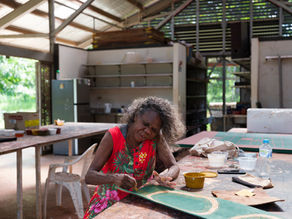Inspired | The Collectors EditionArtists from the Kimberley Region
- Jason Leven

- Jun 28, 2023
- 3 min read

Inspired | Artists from the Kimberley Region
Few areas in Australia, if any, have an artistic history reaching further back than the Western Kimberley. Here, the artistic tradition stems from rock painting, mostly of the deeply important Wandjina Deity, which still forms the basis of contemporary imagery, now painted mostly on bark and canvas. Some Wandjina cave paintings date as far back as 40,000 years. There are few things more deeply rooted in this continent. The artists still use the very marrow of their land - natural earth pigments (ochres) - dug from the soil to relate their Country on canvas.
In the East Kimberley however, the artistic practice finds its roots more recently, formed around the founders of the Gija art movement, including Rover Thomas, Paddy Jaminji and Hector Jandany. Queenie McKenzie, under the urging of Rover Thomas, was the first female Kimberley artist to paint and exhibit her own works.
Developed most famously by Rover Thomas, the language of landscape is unique to this area, with Country viewed neither from the birds eye perspective prominent in Central and Western Desert art, nor from the standing viewpoint employed by European landscape painters. These paintings can be restrained, using few colours to depict vast swathes of land. Yet artists often populate the landscape, as did Queenie McKenzie and Hector Jandany, both of whom populated their canvases with a mix of traditional Gija and Christian iconography. Many of Rover Thomas and Paddy Jaminji’s figurative works are built around the important Kril Kril ceremony. Many of these works, now housed in major collections, still bear the handprints from their ceremonial use.

Alec O’Halloran, through his ‘inquisitiveness that slowly turned into fascination’, went from a self-proclaimed novice to a deeply engaged researcher, collector and author about Aboriginal art. He began studying and collecting art from the Kimberley in the mid 1990s. His fascination with the region led him to travel widely in the West and East Kimberley to visit communities and meet the artists to understand more deeply the imagery and meaning in their beautiful ochre works. His recent authorised biography of Pintupi artist Mick Namarari Tjapaltjarri, ‘The master from Marnpi’, reveals Namarari’s extraordinary life and art career and is available at Cooee.
After decades teaching at the Humboldt University in Berlin, Germany, political scientist Dr. Prof. Patricia Springborg has recently returned home to Australia. Trailing the author by sea was a large container filled with Springborg’s art collection, featuring many of Australia’s biggest names. Curated with care and precision, a prominent component of the art ark was the collection of ochre works from the Kimberley, many of which feature in this exhibition.
“It was only in 2005, during a trip to Aboriginal Art Centres in Arnhemland and the Kimberleys, that I began collecting, which quickly became a passion. It was a great privilege for me to be able to hang these beautiful art objects, which are in fact far more than just art objects, and part of this continent’s historical record, on my walls in Berlin for 10 years, where they attracted a lot of interest.
I am proud to say that I collected works by some of the founders of the Arnhemland and Kimberly art movements, and that my collection includes the very same artists whose works hang in the Australian indigenous section of the famous Musee du Quai Branly in Paris, which has perhaps the most extensive Aboriginal collection in Europe and has played a major part in the movement’s appreciation overseas.”









